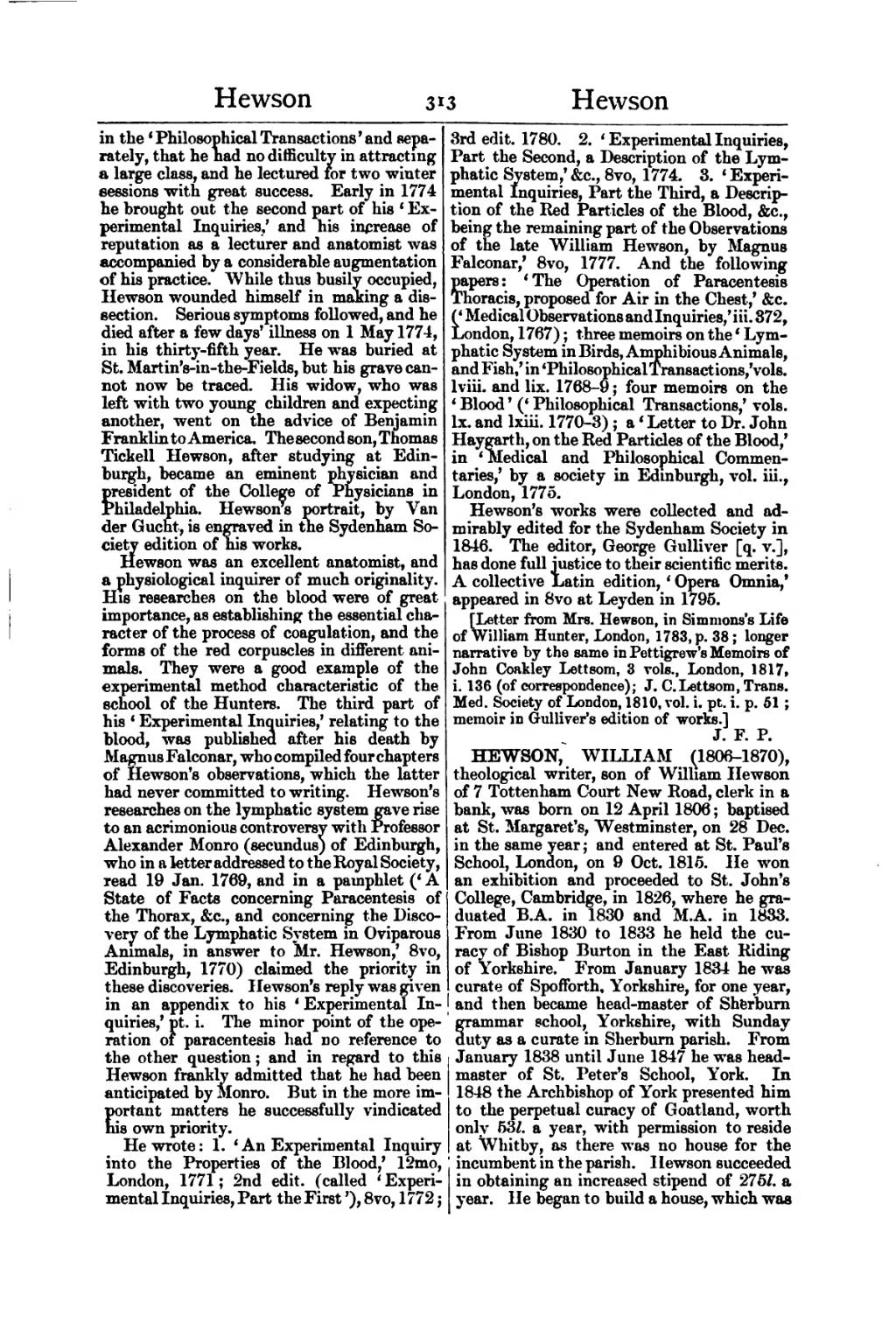in the ‘Philosophical Transactions’ and separately, that he had no difficulty in attracting a large class, and he lectured for two winter sessions with great success. Early in 1774 he brought out the second part of his ‘Experimental Inquiries,’ and his increase of reputation as a lecturer and anatomist was accompanied by a considerable augmentation of his practice. While thus busily occupied, Hewson wounded himself in making a dissection. Serious symptoms followed, and he died after a few days' illness on 1 May 1774, in his thirty-fifth year. He was buried at St. Martin's-in-the-Fields, but his grave cannot now be traced. His widow, who was left with two young children and expecting another, went on the advice of Benjamin Franklin to America. The second son, Thomas Tickell Hewson, after studying at Edinburgh, became an eminent physician and president of the College of Physicians in Philadelphia. Hewson's portrait, by Van der Gucht, is engraved in the Sydenham Society edition of his works.
Hewson was an excellent anatomist, and a physiological inquirer of much originality. His researches on the blood were of great importance, as establishing the essential character of the process of coagulation, and the forms of the red corpuscles in different animals. They were a good example of the experimental method characteristic of the school of the Hunters. The third part of his ‘Experimental Inquiries,’ relating to the blood, was published after his death by Magnus Falconar, who compiled four chapters of Hewson's observations, which the latter had never committed to writing. Hewson's researches on the lymphatic system gave rise to an acrimonious controversy with Professor Alexander Monro (secundus) of Edinburgh, who in a letter addressed to the Royal Society, read 19 Jan. 1769, and in a pamphlet (‘A State of Facts concerning Paracentesis of the Thorax, &c., and concerning the Discovery of the Lymphatic System in Oviparous Animals, in answer to Mr. Hewson,’ 8vo, Edinburgh, 1770) claimed the priority in these discoveries. Hewson's reply was given in an appendix to his ‘Experimental Inquiries,’ pt. i. The minor point of the operation of paracentesis had no reference to the other question; and in regard to this Hewson frankly admitted that he had been anticipated by Monro. But in the more important matters he successfully vindicated his own priority.
He wrote: 1. ‘An Experimental Inquiry into the Properties of the Blood,’ 12mo, London, 1771; 2nd edit. (called ‘Experimental Inquiries, Part the First’), 8vo, 1772; 3rd edit. 1780. 2. ‘Experimental Inquiries, Part the Second, a Description of the Lymphatic System,’ &c., 8vo, 1774. 3. ‘Experimental Inquiries, Part the Third, a Description of the Red Particles of the Blood, &c., being the remaining part of the Observations of the late William Hewson, by Magnus Falconar,’ 8vo, 1777. And the following papers: ‘The Operation of Paracentesis Thoracis, proposed for Air in the Chest,’ &c. (‘Medical Observations and Inquiries,’ iii. 372, London, 1767); three memoirs on the ‘Lymphatic System in Birds, Amphibious Animals, and Fish,’ in ‘Philosophical Transactions,’ vols. lviii. and lix. 1768–9; four memoirs on the ‘Blood’ (‘Philosophical Transactions,’ vols. lx. and lxiii. 1770–3); a ‘Letter to Dr. John Haygarth, on the Red Particles of the Blood,’ in ‘Medical and Philosophical Commentaries,’ by a society in Edinburgh, vol. iii., London, 1775.
Hewson's works were collected and admirably edited for the Sydenham Society in 1846. The editor, George Gulliver [q. v.], has done full justice to their scientific merits. A collective Latin edition, ‘Opera Omnia,’ appeared in 8vo at Leyden in 1795.
[Letter from Mrs. Hewson, in Simmons's Life of William Hunter, London, 1783, p. 38; longer narrative by the same in Pettigrew's Memoirs of John Coakley Lettsom, 3 vols., London, 1817, i. 136 (of correspondence); J. C. Lettsom, Trans. Med. Society of London, 1810, vol. i. pt. i. p. 51; memoir in Gulliver's edition of works.]
HEWSON, WILLIAM (1806–1870), theological writer, son of William Hewson of 7 Tottenham Court New Road, clerk in a bank, was born on 12 April 1806; baptised at St. Margaret's, Westminster, on 28 Dec. in the same year; and entered at St. Paul's School, London, on 9 Oct. 1815. He won an exhibition and proceeded to St. John's College, Cambridge, in 1826, where he graduated B.A. in 1830 and M.A. in 1833. From June 1830 to 1833 he held the curacy of Bishop Burton in the East Riding of Yorkshire. From January 1834 he was curate of Spofforth, Yorkshire, for one year, and then became head-master of Sherburn grammar school, Yorkshire, with Sunday duty as a curate in Sherburn parish. From January 1838 until June 1847 he was head-master of St. Peter's School, York. In 1848 the Archbishop of York presented him to the perpetual curacy of Goatland, worth only 53l. a year, with permission to reside at Whitby, as there was no house for the incumbent in the parish. Hewson succeeded in obtaining an increased stipend of 275l. a year. He began to build a house, which was
